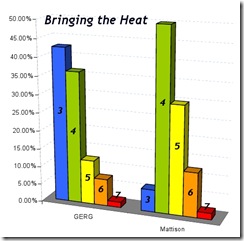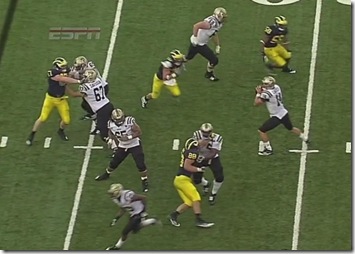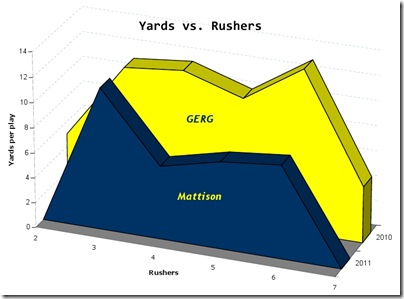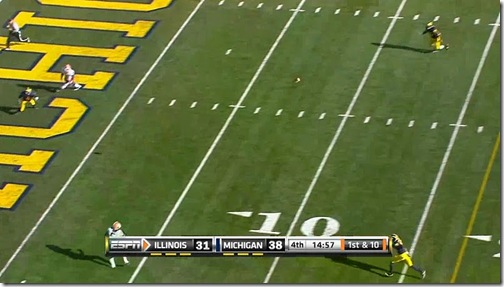Hump Hypotheses: A More Aggressive Greg

Title note: Since Brian moved this column to Wednesday morning, "Museday" is now "Hump Hypotheses," until that name also becomes stupid. New format, same old Miso soup.
Question: Against SD State we finally got to see Michigan play a full game against a pass-oriented offense. Against this Michigan usually sent four rushers, occasionally more. Last year I seem to remember this being three (out of a base 3-3-5) more often. I wonder if the extra rusher is making  Michigan more effective against the pass this year?
Michigan more effective against the pass this year?
Declaration of biases: Eeeeee Mattison.
Research: Thx Brian for adding rush stats to UFR since ND 2010. Yoink. Since it's not available yet I had to do my own SD State charting. From this I took out anything that looked like an end-of-half/4th quarter prevent, plus all of the runs, big play-action, waggles, and any plays from inside the 10, which make it hard to gauge if there were any late blitzers. I also excised last year's game against Purdue because that was played in a monsoon against Perry the Torn ACLephant.* Then I went about determining if each of those plays was a "Win" for the defense, defined thusly:
- 1st down: If the offense gained less than 1/2 of the yards for a first down (so 5 yards from 1st and 10) that's a "Win"
- 2nd down: less than 2/3 of the yards to first down=Win
- 3rd or 4th down: if the offense does not get the 1st down
- Turnovers are obviously Wins.
Incompletes go for zero yards—if the pass went to Tacopants, well it's results-based charting. Have at it.
--------------------------------------------------------
*Michigan spent the whole day rushing three and this worked pretty much 90% of the time.
--------------------------------------------------------
Hypothesis: We were right to be saying "Michigan sends 3 ARRRGGGHHH!" last year. Sending four this year is helping the defense improve.
Let's test that: In case your eyes haven't picked this up already, Mattison sends more guys after the passer. He's averaging about 4.5 rushers per pass play, versus GERG's 3.9 among those we count from last year. Here's a tendency chart:
| Rushed: | 2 | 3 | 4 | 5 | 6 | 7 |
|---|---|---|---|---|---|---|
| 2010 (GERG) | 0.4% | 41.3% | 36.9% | 12.3% | 7.5% | 1.6% |
| 2011 (Mattison) | - | 6.1% | 50.0% | 29.8% | 12.3% | 1.8% |
This is not just a difference of a 4-3 defense versus a 3-3-5. Mattison has called a lot of zone blitzes where a DL backs into coverage, and the 3-3-5 is designed to often have one or two guys coming. Michigan's defense in 2011 is more aggressive than it was last year. Using the W/L formula above, let's see how much more effective it is because of that:
GERG in 2010:
| Rushed: | 2 | 3 | 4 | 5 | 6 | 7 | Total |
|---|---|---|---|---|---|---|---|
| Win | 1 | 61 | 43 | 18 | 10 | 3 | 136 |
| Loss | 43 | 50 | 13 | 9 | 1 | 116 |
Contrary to my memory, Robinson's 3-man rushes were kind of effective by this simple win/loss method. Everything else was flipping a coin.
I counted this as sending five; Gordon was covering the RB and
stepped up when he saw his man was in pass pro.
Mattison in 2011:
| Rushed: | 2 | 3 | 4 | 5 | 6 | 7 | Total |
|---|---|---|---|---|---|---|---|
| Win | - | 2 | 27 | 20 | 8 | 2 | 59 |
| Loss | - | 5 | 30 | 14 | 6 | 55 |
He's definitely sending more guys. Effectiveness seems to be..wait, down?:
| Rushed: | 3 | 4 | 5 | 6 | 7 | Total |
|---|---|---|---|---|---|---|
| GERG | 58.7% | 46.2% | 58.1% | 52.6% | 75.0% | 54.0% |
| Mattison | 28.6% | 47.4% | 58.8% | 57.1% | 100.0% | 51.8% |
AAHHHHHHH this isn't right. This can't be right. Well for one Mattison barely ever sends three. He did it once versus SDSU, and that when Michigan was up 28-7 with 5 minutes left in the 4th quarter. It went for 15 yards. However when I look at the wins and losses when the game is within 8 points it's still way favoring GERG:
| Coach | Win | Loss | Total |
|---|---|---|---|
| GERG | 100 | 77 | 177 |
| Mattison | 18 | 29 | 47 |
AHHHHHHH. This is literally not what I expected. Maybe my Wins and Losses thing is just stupid. Let's do this by simple yards per play when Michigan rushes…
| Rushed: | 2 | 3 | 4 | 5 | 6 | 7 | Total |
|---|---|---|---|---|---|---|---|
| GERG | 5.0 | 7.7 | 9.1 | 6.2 | 8.3 | 2.3 | 8.0 |
| Mattison | 11.3 | 5.2 | 5.4 | 5.2 | - | 5.5 |
And there you see it. I may have found what's throwing me off here. The Pass/Fail nature of my system was not showing that when GERG's defense failed, it failed BIG. Look what happens to yards per pass when I only count the "Loss" plays:
| Rush 3 | Rush 4 | Rush 5 | Rush 6 | Rush 7 | |
|---|---|---|---|---|---|
| GERG | 16.5 | 14.8 | 16.6 | 19.3 | 19.0 |
| Mattison | 13.6 | 10.8 | 12.7 | 11.8 | - |
When the 2010 pass defense failed, it didn't just give up the first down, but often a good chunk afterwards. The 2011 defense is still 50/50 to get the job done on any given passing play, but at least they're living to see the next series more often than not. That means more chances per drive for a turnover.
Last bit, just to see if this is changing running stats:
| Rush YPC | Rush YPG | Rush TDs/Game | Pass TDs/game | |
|---|---|---|---|---|
| 2010 (All of it) | 4.4 | 188.9 | 2.6 | 1.6 |
| 2011 (4 games) | 4.7 | 156.0 | 0.5 | 1.0 |
Er. My expectation here was that Rushing YPC would be way down due to an extra rusher being around when a running play is called, but they're actually up a good bit. However the TDs given up are way way down. That combined with not once have we seen a freshman corner vacate his zone in dime, and this defense looks like it's already at mediocre and learning things that might make them good.
Holding this to 15 yards maybe should be a win.
Draw a Conclusion: Mattison hasn't even faced the best teams on his schedule yet so I can't claim anything is better or fixed. What I can say is the theory that the huge flip in turnover margin this year and/or improved defensive back play is probably having a bigger effect on Michigan's apparent defensive improvement than line scheme/aggressiveness. The data are way too close and inconclusive to draw anything for certain, and four games is not enough to assess, especially considering it's the first four games with this defense. But it is kind of interesting to see that rushing the extra guy seems to be doing a better job of keeping down the big plays than having eight men in coverage. That was really unexpected, though again it probably has a lot more to do with the efficacy of the specific defensive backs in coverage more than scheme.
------------------------------------------------------------------------
Bonus: here's how they do on each down:
| 1st | 2nd | 3rd | 4th | |
|---|---|---|---|---|
| GERG | 50.57% | 56.47% | 57.53% | 28.57% |
| Mattison | 48.98% | 48.65% | 57.69% | 100.00% |
September 28th, 2011 at 11:16 AM ^
Why are you implying that having a mobile quarterback is somehow incompatible with Manballian offense? Scheme and QB mobility are completely different things.
September 28th, 2011 at 11:11 AM ^
How about "Humpotheses?" Who's with me?
...
*lowers hand sheepishly*
September 28th, 2011 at 11:13 AM ^
Sorry for the poor formatting but I can't block quote on MgoDroid.
http://m.espn.go.com/nfl/story?storyId=7025800
Below is an excerpt from ESPN commentator and former NFL player Ross Tucker. He seems to think turnovers are more game plan now than they have been in the past in the NFL. I wonder if the same can be said about the 2011 Michigan defense? A lot of Blitz packages, aggressiveness toward the football and a certain former NFL DC are clues this might be the case.
Q. There seems to be a big emphasis on how many yards a defense allows. But with offenses putting up much bigger yardage totals these days, especially with these no huddle offenses, are yards becoming less of a concern to defensive coordinators than creating turnovers and keeping the offense out of the end zone? Ultimately you want to win the game, and yards don't necessarily equate to scores. So why the emphasis on yardage totals if defenses are keeping offenses out of the end zone and winning the game?
Mark from Greensboro, N.C.
A. Total yardage is and always has been a silly way to rank offensive and defensive units. I'm on record as saying that in today's NFL, total passing yards has to be the most overrated stat out there. It seems like most of the highest passing totals each week are by quarterbacks who did so in a losing effort and racked up a lot of those yards in the fourth quarter. What matters ultimately is points. For instance, the Saints' ability to hold the Texans to field goals instead of touchdowns and get the timely Jabari Greer interception in the fourth quarter was ultimately the difference in that game.
September 28th, 2011 at 11:29 AM ^
Well yes, total stats are not that important. However I do put faith in per-play numbers IF you excise all the plays where the offense and defense are not functioning in their normal modes.
Scoring is "all that matters" when it comes to wins. But turnovers and field position (and things like being able to kick a field goal) add a lot of noise to scoring numbers.
Think of it this way: would you rather have the 2008 Michigan offense and start on the opponent's 40 every possession, or have the 2011 Michigan offense and start on your own 20? Advanced stats will say take the 2008 offense because 50 yards of field position is worth being only half as good at moving the ball.
Red zone scoring % doesn't seem to be very repeatable year to year except it goes up with lots of returning starters. I think this means there's something to be said for quicker decisions and more discipline that serves teams well closer to the end zone, while scheme maybe plays more of a role across the rest of the field. Specifically a spread offense, which conceptually uses the entire depth of the field as well as its width, should be expected to diminish in value as there's less depth of the field to stretch.
September 28th, 2011 at 11:30 AM ^
Hi, I'm looking for a guy named Brian... he used to work here. Do you have a forwarding address?
September 28th, 2011 at 11:34 AM ^
Try:
Brian Cook
c/o The Dreamy World of the Subconscious
P.O. Box UFR vs. SDSU
Video Uploading, MI 48104
September 28th, 2011 at 11:33 AM ^
A major impact on our defense from going from bad to non existent was the injury to Mike Martin at the end of the MSU game. With him hobbled our run defence became deficient and what modicum of a pash rush there was went to zero.
I would be interested in seeing how the numbers played out if you evaluated UM's defense through the MSU game and then compared Iowa to the bowl game.
September 28th, 2011 at 11:51 AM ^
I think you nailed it with Miso Soup!
September 28th, 2011 at 12:22 PM ^
Awesome attempt to quantify and make sense of the differences. At this point, I think the dataset is too small for a meaningful analysis on defense. We need to compare BIG year to year and we haven't gotten there yet. Overall, I don't need the numbers for the defense to validate what I am seeing thus far:
- Our players seem to be better coached at the fundamentals (tackling, coverage, etc.)
- I don't cringe everytime I see our defense take the field.
- Even with injuries subs seem to be contributing in an effective manner
It is clear to me that Mattison is the real deal on Defense. Which really shouldn't suprise anyone. I mean do we really need to compare the former Defensive Coordinator for the Ravens to GERG. He is using what we have in the most effective manner he can, and it has been working out for us. Our defense has more confidence in this system and with Mattison at the helm, so for me it would be virtually inconceivable that we would not be much better in BIG play. We also seem to be improving week to week in a noticible manner.
September 28th, 2011 at 12:43 PM ^
breaking down win/fail based upon what down it is?
Maybe I'm mis-reading your data. It seems you base wins upon what they do each down but I don't think I see anything that shows how often a team wins on 1st down, 2nd down, 3rd down no matter how many rushers they are sending.
Winning on 3rd down is huge because it gets the defense off the field. A cavaet might be that Gerg's teams didn't face many 3rd downs because they were giving up 10 yds on 1st or 2nd down. You can lose 1st down, lose 2nd down but if you win 3rd down, that series is utlimately a win for the defense even though they technically only won one of the three plays.
September 28th, 2011 at 12:46 PM ^
GERG ran a break, but don't bend defense?
<br>
<br>Come to think of it his hair never bent either.....
September 28th, 2011 at 12:47 PM ^
Good analysis, and so far so good grom Mattison. Id like to see how Gerg and Mattison stack up at the end of the year when Mattisons sample size is a bit larger and big ten tested however.
September 28th, 2011 at 1:02 PM ^
The real comparison between the coordinators will come when we have a full Big 10 schedule under our belts with Mattison. Recall that GERG was also undefeated in non-conference play both seasons he was DC, which obviously didn't mean a thing.
Regardless of what the stats show right now, I feel much more comfortable with Mattison's style and schemes, and this isn't simply due to his past reputation. Michigan's defense just looks better and more coherent (most of the time) on the field this year and I feel like I have a legit reason for hope of improvement as the kids get more comfortable with him.
September 28th, 2011 at 1:06 PM ^
As I recall from reading various things on six sigma manufacturing, the first thing you need to do is reduce variation in your process. Then you begin to upgrade the quality of each step. When I look at the numbers it's obvious Mattison does not have a ridiculously better defense here yet. But he does have a defense with much less variation in yards given up per play. In English: they don't give up lots of big horrendous dong punching plays. And I think it will be easier to improve from a stable platform than it would have been standing in the burning tire fire that was GERG's defense.
September 28th, 2011 at 1:33 PM ^
Good lord those 4th down numbers are terrible. Also, what about an apples-to-apples comparison of the the first 4 games of 2010 to the first four of 2011? Opponents were comparable at that point and I imagine some of GERG's numbers are skewed higher due to the later games.
September 28th, 2011 at 2:13 PM ^
I mentioned this above to another commenter: Brian started keeping track of pass rushing in UFR for ND last year, and new metrics usually take a few weeks to work out the kinks. I would basically have ended up comparing the system now to the system then instead of getting anything useful from the data. And I would have had to do UConn on my own.
If you scroll up I did show how the 2010 ND game skewed GERG's numbers to look good. There's a stretch of 7 plays where he was getting a 57% win, but gave up a 53-yard TD and turned a 3rd and long from punt range into 1st and 10 on M's 6 with the three losses. Those 7 plays are actually sandwiched between two other long TDs (including the 95-yarder). In all of that GERG came out positive in the W/L.
September 28th, 2011 at 2:34 PM ^
Pardon a dumb question (since most of you seem to know the answer), but what does "GERG" mean?
I know who it refers to but not the significance.
thx.
September 28th, 2011 at 2:40 PM ^
I'm glad you went beyond teh W/L thing you tried. I think what you've shown is simply that your W/L method just doesn't work. You should maybe stay away from that type of analysis again...or find a different way to do the binary-type thing. I definitely understand the motivation behind such a simple analysis system...but when a 53-yd touchdown and giving up 5 yards on 1st down count equally in the system as a loss, I don't think the results will be very reliable.
Still, there are some interesting conclusions to be drawn even from this. Combined with our eyes and the scoresheets telling us that obviously this D is improved over last year (even allowing for luck in the TOs), the fact that Mattison still grades out worse shows that the defense still gives up bad plays...but they limit the bad from being terrible. That is an important first step in going from terrible D to respectable D.
September 28th, 2011 at 2:54 PM ^
Hey Miso - I'm a big fan of your work. If you want some unsolicited advice I think you're over-thinking the name for this column. Does it need a cutesy name? I'd go with something plain like the "Wednesday Misopogon Report," "Wednesday Hypotheses" or something like that. "Hump Hypotheses" sounds like some kind of gay scientist porno (which I assume isn't what you're going for)...





Comments